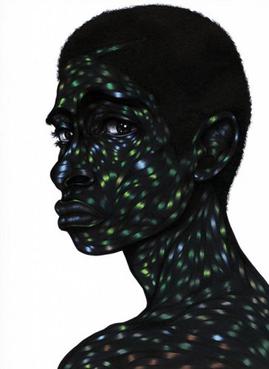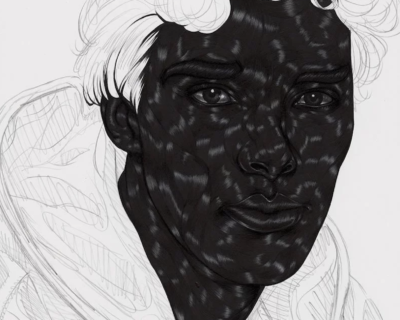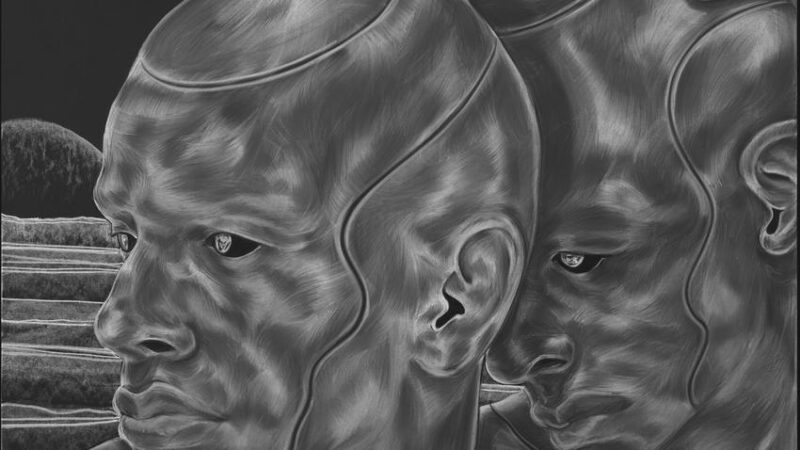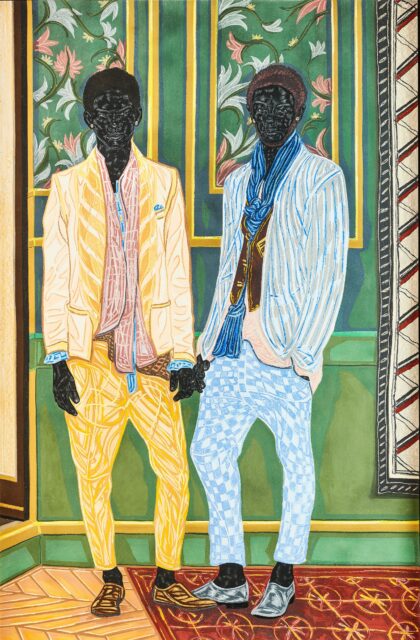Toyin Ojih Odutola: Mythology and Lines
Emma Chaaban
Knowledge, 345-101-MQ

European colonialism of the past few centuries has impacted the way most of the Western Hemisphere, if not the entire world, sees itself. Not only white people, but even black people often see themselves through white lenses. According to Kazanjian, even renowned black artists resort to white masterpieces “to give identity to the black figure”. Then comes a new generation of artists, such as Toyin Ojih Odutola, who no longer want to be seen as the other. In her body of work, Odutola makes use of various artistic techniques and creates mythologies in order to shift the viewer’s perception of black identity and allow it to take centre stage.

Odutola’s use of various artistic techniques, such as mark-making, the use of ball-point pen, charcoal and pastel, and the space and attitude her subjects occupy on the canvas, aim to demonstrate various clear ideological points about blackness, oppression and the effect of colonialism. Firstly, Odutola dedicates time and artistry in order to introduce the viewer to black skin at a deeper level. Early in her career, “she presented… a series of painstakingly detailed portraits in ballpoint pen, entitled ‘(MAPS)’, which sought to represent Black skin as a kind of geographical expanse (a ‘terrain of one’s being’, in her own words)” (Reilly). The texture obtained by employing various pen pressures created an artistic impact of its own. This technique allowed Odutola to place emphasis on the feel of black skin, beyond its colour. She later discovered charcoal and pastel, which provided her with the ability to portray black skin in a more intimate and nuanced fashion. According to the artist herself: “The beauty and the reality of blackness is multi-tonality” (Nwangwa). The dedication and attention given to illustrating black skin is significant because it presents black skin as something of great worth.

On the other hand, as she worked on presenting black skin as valuable, Odutola has dedicated some works and exhibitions to removing importance from white skin. For example, in her exhibit, titled The Treatment, she presented black-skinned portraits of prominent white men, which she thereby “robbed of their whiteness (i.e., their “importance”)” (Kazanjian). This play on skin colour puts in question the value we attribute to it.
Additionally, she presents her dark-skinned subjects in very mundane, unapologetic positions or on gigantic canvases, thereby claiming their space in the world. “Diasporic people of colour cannot take up space, she suggested, but her portraits’ subjects defy this smallness… ‘so that you can stop thinking it’s a black person’ ” (Nwangwa). Through her use of space and subject positioning, Odutola means to claim a vital space on behalf of the black community, it’s as though she is saying: we are important enough to be subjects of great art, even when everyday people are presented in inconsequential situations and poses.

Last but not least, Odutola uses expert striations and marks-making skills to tell a story of oppression and carry us through her narrative. Everything is about the line, whether it is in the little lines made in pen on a subject’s skin to denote its texture and tattooing it firmly onto the canvas, or the various marks that evolve through her series called A Countervailing Theory. “The action of A Countervailing Theory takes place against a mutating backdrop of complex, changing patterns of lines…that manifest the unspoken systems of oppression that govern the characters’ behaviour. The servile male underclass is distinguished throughout by curvilinear markings… being carved into the skin by their female rulers, literally delineating their servitude until, in the final climactic moments, the lines become blurred” when the world is shaken by a cross-class relationship and the birth of twins of mixed races (Reilly). Through her use of lines that tell a long story and of lines branding a sub-class of beings, Odutola makes us consider the long-term effects of oppression and questions its right to be.

Further to her artistic techniques, Odutola creates whole fictitious mythologies to allow the viewer to question the impact of colonialism, power dynamics, and accepted perceptions of blackness and sexual orientation. Odutola created two very elaborate exhibits, where all the artwork belongs to a single storyline. One is a three-part saga depicting two fictional wealthy Nigerian families, joined by the marriage of the two male heirs. It is purposely subversive, as in Nigeria, homosexuality is illegal and carries a lengthy prison penalty. According to Odutola, “the work is a narrative ‘about wealth and nobility, and the sort of self-possession and ownership of capital that surrounds you, instead of you being the capital… it’s a meditation on what might have been possible in Africa if colonial conquest had never happened” (Kazanjian). In other words, this exhibit makes a point about sexual freedom and mainly examines the impact of colonialism on Africa by creating an alternate universe, where colonialism never happened and African people have wealth instead of being the wealth of slave owners.
The other exhibit, where Odutola presents an alternate world, is called A Countervailing Theory, which presents a series of 40 monochrome drawings of different sizes that tell the story of the foundation myth of an imaginary prehistoric civilization located in the Jos plateau of Nigeria. It is the story of forbidden love between two people of two very distinct classes. Again, as in the trilogy, the exhibit depicts a story of forbidden love, and although this time, it is between a man and a woman, it still questions society’s ability to impose barriers to choice. It also illustrates, Odutola’s use of “flipping the script” or “countervailing“ as the narratives upend the power structures of the fictional worlds they conjure, which are themselves inversions of our own, they direct attention to the structures of oppression, rather than the actors” (Reilly). The artist thus uses story-telling in a cinematic novel-like way to remove focus from who oppressed whom in history, and focus solely on the mechanics, the value and the effect of the said oppression.
Odutola reclaims the right of blacks to their own universe and perception of reality, as a whole experience on its own, without having to anchor it on the white experience and colonial impact. She doesn’t use ‘white’ norms, she simply “imagines a contemporary world in which blackness is the norm” (Kazanjian). In addition, she gives life to origin myths and alternate universes, where colonization never happened and gives space, in every meaning of the term, to the black experience from black skin to simple enjoyment of every day pleasures. In her own words: “Black stories can be ridiculous… silly… boring… Can we have that privilege now? Instead of having to be exceptional all the time?” (Kazanjian). Simply put, her body of work claims the right of blacks to simply be and not have to be exceptional to be worthy.
Works Cited
Kazanjian, Dodie. “Reimagining Black Experience in the Radical Drawings of Toyin Ojih Odutola.” Vogue, July 17, 2018, www.vogue.com/article/toyin-ojih-odutola-interview-vogue-august-2018.
Nwangwa, Shirley. “ ‘Mark-Making As a Land Your Eyes Traverse’: Toyin Ojih Odutola Talks with Zadie Smith.” ARTnews, Dec. 6, 2018.
Reilly, Samuel. “Toyin Ojih Odutola.” Gale Academic Onefile, Apollo, vol. 192, no.692, Dec. 2020, link.gale.com/apps/doc/A651902261/AONE?u=west74079&sid=AONE&xid=22d4b3af.
Image Credits (in order of appearance)
Tojin Ojih Odutola, photographed by Alec Soth, Vogue, August 2018
Lonely Chambers (T.O.), 2011, pen ink and marker drawing on paper drawing by Toyin Odutola
The Treatment 26, 2015, pen, gel ink, and pencil on paper by Toyin Ojih Odutola. Jack Shainman Gallery, New York
Semblance of Certainty, 2019, from A Countervailing Theory by Toyin Ojih Odutola. Jack Shainman Gallery, New York
Newlyweds on Holiday, 2016. Charcoal, pastel and pencil on paper by Toyin Ojih Odutola. Jack Shainman Gallery, New York.


